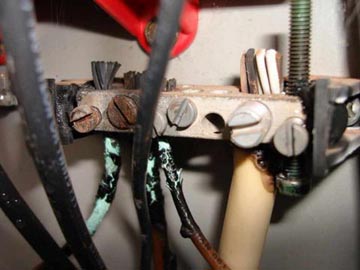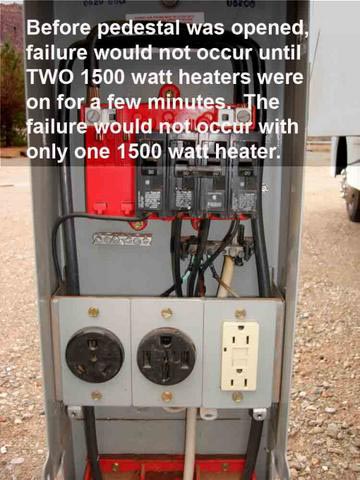I talked to the camper, and he said that the microwave started
smoking shortly after he turned on the electric heating element for his
water heater. I turned the power back on for that part of the campground
and checked the power pedestal, and the voltages were fine. I suspected an
open neutral problem because the microwave smoking was related to turning
on the water heater heating element, and there should be only a very minor
correlation. I used my test adapter, which plugs into a 50-amp outlet and
has two regular outlets, each connected to one of the hot lines. I tested
the voltage with a 1500 watt heater, and the voltages remained good. We
then turned off all the breakers in the motorhome except for two circuits
where we could be sure that only outlets that we could control would
receive power.
We applied power to the motorhome and plugged a heater in while measuring
the voltage between neutral and ground on one of the un-powered motorhome
outlets, We read about two volts. I also had a voltmeter connected to the
power pedestal so I could isolate where the open neutral was if we could
get it to occur, and between neutral and ground I also read about 2 volts.
After several minutes without a failure we added a second heater inside
the motorhome. About a minute or two later the failure occurred, and there
was 80 volts between neutral and ground at the un-powered outlet in the
motorhome, and about the same at the power pedestal. This means that with
the two heaters on, anything on the other hot line would be getting about
200 volts.
Since the voltage was bad at the power pedestal, the problem was not with the motorhome.
We then talked to the campground owner and got permission to open the power pedestal. All the wires going to the neutral buss were discolored, and the insulation had either burned or melted.
|
|
|
 |
The power pedestal is less than a year old. It was made by Milbank, which is probably the most common manufacturer of power pedestals. As you can see from the photos, the hot and neutral lines coming into the pedestal are large (0000 gauge), and the clamps for these wires are also very large. There are secondary large wires that carry the hot lines to the circuit breakers, and these clamps are also large. The problem is that the neutral buss is way too small, and it's not thick enough to be able to apply sufficient torque to the neutral wires without stripping the threads. This is what leads to so many open neutral failures. |
Another important thing here is that the failure did not occur with only one 1500 watt heater -- it took two 1500 watt heaters and some time. This means that any electrical protection device would not have caught the failure before power was applied to the motorhome because they don't apply any load. My test adapter that lets me test voltage using a hair dryer for a load is also insufficient. I'm going to need to plug in as many hair dryers or heaters as needed to at least equal the current I expect to draw with the motorhome, and then leave the load on for a few minutes to make sure enough heating of the pedestal connections has occurred.
An electrical protection device would have cut power off after the failure had occurred, which possibly could have reduced the failures in the motorhome if the failures were over heating due to the higher voltage, and not the higher voltage immediately destroying solid state devices. Power supplies for electronic equipment might be able to last long enough to survive if the power was cut fast enough to prevent over heating.
The obvious question is what can we do to protect ourselves. If you only plug into 30-amp power you're significantly safer because an open neutral will almost always only result in lower voltage. Someone previously suggested plugging into two 30-amp adapters, hoping that they would both be the same phase. The campground we're in is wired correctly, with the hot lines reversed at every other pedestal. Doing that somewhat equalizes the current from campers that use 30 amp power. It also means that adjacent 30-amp outlets are wired out-of-phase, and an open neutral could result in 240 volts being applied to half your motorhome. You'd have a better chance of not losing the neutral line if your adapter to allow you to connect to two 30-amp outlets uses both neutrals, but you could still get hit if your motorhome neutral opens, or the campground neutral opens before the power pedestals. Making an adapter that only uses one leg of the 50-amp power would save you from open neutrals that are in your pedestal or your motorhome (but not before your pedestal). Doing this would also increase the current in the neutral line, which likely would induce more neutral line failures. Normally only the difference in current between the two hot lines winds up flowing in the neutral line (i.e. if you're drawing 30 amps on one hot line and 20 in the other, the neutral line would be carrying 10 amps).
I think the best way is to test the outlet with more current than you are going to draw for at least several minutes. Having an electrical protection system would add protection for things that get destroyed from over heating, but they also have a relatively high failure rate, so you might want one that plugs in rather than being hard-wired.
-- Daryl Daughters, 2002 MADP, Fulltiming for over 5 years, and
still
having lots of fun

